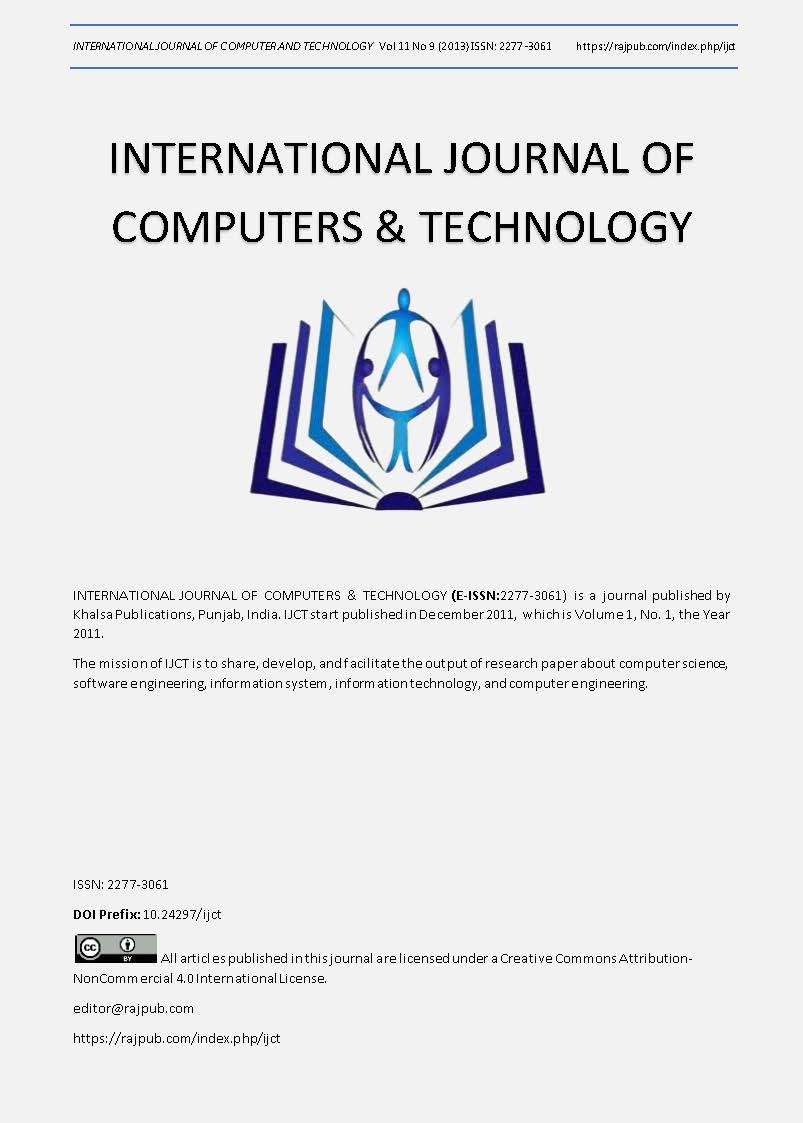An Intelligent AntNet-Based Algorithm for Load Balancing in Grid Computing
DOI:
https://doi.org/10.24297/ijct.v11i9.3406Keywords:
Computational Grids, Load Balancing, Ant Colony, Performance Optimization.Abstract
Computational grids have a huge number of diverse and scattered resources that are used in handling complex problems. A decent load balancing methodology is needed to utilize grid resource by efficiently distributing tasks, for execution, on available computing nodes.
Ant colony is a major and popular method for approximate optimization. It works by simulating the actual ant‟s demeanor in detecting the best path for the resources of food. This research paper employs ant colony optimization in proposing a load balancing technique for computational grids. The performance of the suggested technique is computed, evaluated and compared with that of a Random Distributed Load Balancing technique using simulation. The achieved results reveal that the suggested technique enhances the task average response time. It reveals also that the enhancement ratio progressively rises up as the system‟s load rises up till the load come to be mild where the best enhancement ratio is achieved. Immediately after that, the enhancement ratio declines steadily as the system‟s load rises up till the system becomes saturated.
Downloads
References
186-194, 2007.
2. B. Yagoubi and Y. Slimani, “ Load balancing strategy for Grid Environmentâ€, Journal of Information Technology and
applications 1(4), p. 285-296, 2007.
3. B. Yagoubi and Y. Slimani, “Dynamic load balancing strategy for Grid computingâ€, World academy of science,
Engineering technology, 19, p. 9095, 2006.
4. F. Berman, G. Fox and Y. Hey. Grid Computing: Making the Global Infrastructure a Reality. Wiley Series in
Communications Networking & Distributed Systems, 2003.
5. R. Buyya, D. Abramson, J. Giddy and H. Stockinger. „Economic models for resource management and scheduling in
Grid computing‟, Journal of Concurrency and Computation: Practice and Experience, 14(13-15): pp.1507-1542,
December 2002.
6. J. Cao, Daniel P. Spooner, Stephen A. Jarvis, S. Saini and Graham R. Nudd. Agent-Based Grid load Balancing
Using Performance-Driven Task Scheduling.: Proceedings of the 17th International Symposium on Parallel and
Distributed Processing, pages 49.2, 2003.
7. T. L. Casavant and J.G. Khul. „A taxonomy of scheduling in general purpose distributed computing systems‟. IEEE
Transactions on Soft. Engineering, 14(2):pp.141-153, 1994.
8. S. F. El-Zoghdy, Kameda, H. and Li J., A comparative study of static and dynamic individually optimal load balancing
policies, Proc. of the IASTED International Conference on Networks, Parallel and Distributed Processing and
Applications, p. 200-205, 2002.
9. S. F. El-Zoghdy, Hisao Kameda, and Jie Li, “A Performance Comparison of Dynamic Vs. Static Load Balancing
Policies in a Mainframe-Personal Computer Network Model,†INFORMATION, Vol. 5, No. 4, pp. 431-446, October
2002
10. Tantawi A. N. and Towsley D. Optimal static load balancing in distributed computer systems. Journal of the
Association for Computing Machinery, 32(2):445–465, April 1985.
11. Li J. and Kameda H. Load balancing problems for multiclass jobs in distributed/parallel computer systems. IEEE
Trans. Computer, 47(3):322–332, 1998.
12. Kameda H., Li J., Kim C., and Zhang Y. Optimal Load Balancing in Distributed Computer Systems. Springer, Tokyo,
1997.
13. J. Zhang, J.H. He, and Y.Fu (Eds): “A Survey of load balancing in Grid computingâ€, CIS 2004, LNCS 3314, p. 280-
285, 2004.
14. Ali Afzal, A. Stephen McGough, John Darlington, “Capacity planning and scheduling in Grid computing
environmentsâ€, Future generation computer systems, 24, p. 404-414, 2008.
15. R. Sharma, V. Kant Soni, M. Kumar Mishra, P. Bhuyan, “A survey of job scheduling and resource management in
Grid Computingâ€, World academy of science, Engineering technology, 64, p. 461-466, 2010.
16. Jagdish Chandra Patni, Dr. M.S.Aswal, Om Prakash Paland Ashish Gupta, “Load balancing Strategies for Grid
Computing†presented at 3rd international conference on electronics computer technology (ICECT), vol.3, pp. 239-
243, 2011.
17. Fangpeng Dong and Selim G. Akl, "Scheduling Algorithms for Grid Computing: State of the Art and Open Problems",
Technical report, School of Computing, Queen‟s University Kingston, Ontario January 2006
18. M. Dorigo and T. Stützle, Ant colony optimization, Cambridge,Massachusetts, London, England: MIT Press, 2004.
19. S. Fidanova and M. Durchova, "Ant algorithm for grid scheduling problem," Lecture Notes in Computer Science, vol.
3743, pp. 405- 412, 2006.
20. S. Suryadevera, J. Chourasia, S. Rathore and A. Jhummarwala", Load Balancing in Computational Grids Using Ant
Colony Optimization Algorithm", International Journal of Computer & Communication Technology (IJCCT), 3(3), pp.
20-23, 2012
21. L. M. Nithya, and A. Shanmugam, " Scheduling in Computational Grid with a New Hybrid Ant Colony Optimization
Algorithm", European Journal of Scientific Research,Vol.62 No.2, pp. 273-281, 2011.
22. Ruay-Shiung Chang, Jih-Sheng Chang, and Po-Sheng Lin," An ant algorithm for balanced job scheduling in grids",
Future Generation Computer Systems 25, pp. 20–27, 2009.
23. Hongbo Liu, Ajith Abraham, Vclav Snšel, and Sen McLoone," Swarm scheduling approaches for work-flow
applications with security constraints in distributed data-intensive computing environments", Information Sciences
192, pp. 228–243, 2012.
24. Yajun Li, Yuhang Yang, Maode M, Liang Zhou," A hybrid load balancing strategy of sequential tasks for grid
computing environments", Future Generation Computer Systems , 25, pp. 819-828, 2009.
25. Y. ZHU, "A survey on grid scheduling systems", Technical report, Department of Computer Science, Hong Kong
University of Science and Technology, 2003.
26. R. Buyya, "A grid simulation toolkit for resource modeling and application scheduling for parallel and distributed
computing", www.buyya.com/gridsim/
27. Yuanyuan Zhang, Wei Sun, Yasushi Inoguchi, "Predict task running time in grid environments based on CPU load
predictions", Future Generation Computer Systems 24 (6) (2008) 489–497.









